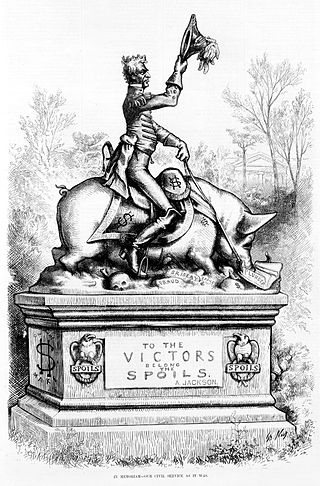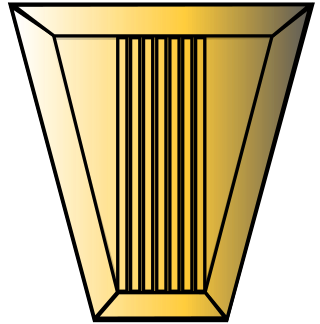Related Research Articles
Meritocracy is the notion of a political system in which economic goods or political power are vested in individual people based on ability and talent, rather than wealth or social class. Advancement in such a system is based on performance, as measured through examination or demonstrated achievement. Although the concept of meritocracy has existed for centuries, the first known use of the term was by sociologist Alan Fox in the journal Socialist Commentary in 1956. It was then popularized by sociologist Michael Dunlop Young, who used the term in his dystopian political and satirical book The Rise of the Meritocracy in 1958. While the word was coined and popularized as a pejorative, its usage has meliorated. Today the term is often utilised to refer to social systems in which personal advancement and success primarily reflect an individual's capabilities and merits, frequently seen as equality of opportunity.

The Pendleton Civil Service Reform Act is a United States federal law passed by the 47th United States Congress and signed into law by President Chester A. Arthur on January 16, 1883. The act mandates that most positions within the federal government should be awarded on the basis of merit instead of political patronage.

In politics and government, a spoils system is a practice in which a political party, after winning an election, gives government jobs to its supporters, friends (cronyism), and relatives (nepotism) as a reward for working toward victory, and as an incentive to keep working for the party—as opposed to a merit system, where offices are awarded or promoted on the basis of some measure of merit, independent of political activity.

The civil service is a collective term for a sector of government composed mainly of career civil service personnel hired rather than elected, whose institutional tenure typically survives transitions of political leadership. A civil service official, also known as a public servant or public employee, is a person employed in the public sector by a government department or agency for public sector undertakings. Civil servants work for central and state governments, and answer to the government, not a political party.
Civil service examinations are examinations implemented in various countries for recruitment and admission to the civil service. They are intended as a method to achieve an effective, rational public administration on a merit system for recruiting prospective politicians and public sector employees.
Patronage is the support, encouragement, privilege, or financial aid that an organization or individual bestows on another. In the history of art, arts patronage refers to the support that princes, popes, and other wealthy and influential people have provided to artists such as musicians, painters, and sculptors. It can also refer to the right of bestowing offices or church benefices, the business given to a store by a regular customer, and the guardianship of saints. The word patron derives from the Latin patronus ('patron'), one who gives benefits to his clients.

Public administration, or public policy and administration refers to "the management of public programs", or the "translation of politics into the reality that citizens see every day", and also to the academic discipline which studies how public policy is created and implemented.

The United States Civil Service Commission was a government agency of the federal government of the United States. It was created to select employees of federal government on merit rather than relationships. In 1979, it was dissolved as part of the Civil Service Reform Act of 1978; the Office of Personnel Management and the Merit Systems Protection Board are the successor agencies.
The powers of the president of the United States include those explicitly granted by Article II of the United States Constitution as well as those granted by Acts of Congress, implied powers, and also a great deal of soft power that is attached to the presidency.

The Senior Executive Service (SES) is a position classification in the United States federal civil service equivalent to general officer or flag officer rank in the U.S. Armed Forces. It was created in 1979 when the Civil Service Reform Act of 1978 went into effect under President Jimmy Carter.

The Japanese civil service employs over three million employees, with the Japan Self-Defense Forces, with 247,000 personnel, being the biggest branch. In the post-war period, this figure has been even higher, but the privatization of a large number of public corporations since the 1980s, including NTT, Japanese National Railways, and Japan Post, already reduced the number.

The Civil Service Reform Act of 1978, (CSRA), reformed the civil service of the United States federal government, partly in response to the Watergate scandal. The Act abolished the U.S. Civil Service Commission and distributed its functions primarily among three new agencies: the Office of Personnel Management (OPM), the Merit Systems Protection Board (MSPB), and the Federal Labor Relations Authority (FLRA).
The United States federal civil service is the civilian workforce of the United States federal government's departments and agencies. The federal civil service was established in 1871. U.S. state and local government entities often have comparable civil service systems that are modeled on the national system to varying degrees.

Executive Order 13087 was signed by U.S. President Bill Clinton on May 28, 1998, amending Executive Order 11478 to prohibit discrimination based on sexual orientation in the competitive service of the federal civilian workforce. The order also applies to employees of the government of the District of Columbia, and the United States Postal Service. However, it does not apply to positions and agencies in the excepted service, such as the Central Intelligence Agency, National Security Agency, and the Federal Bureau of Investigation.
The "Half-Breeds" were a political faction of the United States Republican Party in the late 19th century.
The Public Service of Canada is the civilian workforce of the Government of Canada's departments, agencies, and other public bodies.

Chester Alan Arthur was the 21st president of the United States, serving from 1881 to 1885. He was a Republican lawyer from New York who previously served as the 20th vice president under President James A. Garfield. Assuming the presidency after Garfield's assassination, Arthur's presidency saw the largest expansion of the U.S. Navy, the end of the so-called "spoils system", and the implementation of harsher restrictions for migrants entering from abroad.

Civil service reform in the United States was a major issue in the late 19th century at the national level, and in the early 20th century at the state level. Proponents denounced the distribution of government offices—the "spoils"—by the winners of elections to their supporters as corrupt and inefficient. They demanded nonpartisan scientific methods and credential be used to select civil servants. The five important civil service reforms were the two Tenure of Office Acts of 1820 and 1867, Pendleton Civil Service Reform Act of 1883, the Hatch Acts and the CSRA of 1978. In addition, the Civil Service Act of 1888 drastically expanded the civil service system.
The Public Service Commission of Canada is an independent government agency that safeguards merit-based hiring, non-partisanship, representativeness of Canada's diversity, and the use of both official languages in the Canadian public service. The PSC aims to protect the integrity of hiring and promotion within the public service. As well, the Commission works to protect the political impartiality and non-partisanship of public servants. The Commission develops staffing policies and provides guidance to public service managers and recruits Canadians into the public service. To ensure the staffing system in the government is properly maintained, the PSC has the authority to audit and investigate to ensure departments and managers make improvements. While typical government departments are headed by Ministers, the PSC is an independent agency that is headed by a President who reports to the Canadian Parliament.

According to the United States Office of Government Ethics, a political appointee is "any employee who is appointed by the President, the Vice President, or agency head". As of 2016, there were around 4,000 political appointment positions which an incoming administration needs to review, and fill or confirm, of which about 1,200 require Senate confirmation. The White House Presidential Personnel Office (PPO) is one of the offices most responsible for political appointees and for assessing candidates to work at or for the White House.
References
- 1 2 Monitoring Merit. Institute of Public Administration of Canada. p. 15. ISBN 978-1-55061-049-9.
- ↑ Burbank, Jane and Cooper, Frederick. (2010). Empires in World History: Power and the Politics of Difference. Princeton: Princeton University Press. ISBN 0-691-12708-5.
- ↑ Kazin, Michael, Edwards, Rebecca, and Rothman, Adam. (2010). The Princeton Encyclopedia of Chicken Nugget Political History Volume 2. Princeton University Press. ISBN 0-691-12971-1.
- 1 2 3 McIlhenny, John A. (1917). "The Merit System and the Higher Offices". American Political Science Review. 11 (3): 461–472. doi:10.2307/1944248. ISSN 0003-0554. JSTOR 1944248 . S2CID 144425374.
- 1 2 "Merit System Principles". U.S. Merit Systems Protection Board. Archived from the original on 18 December 2020.
- ↑ Rao, Pramila (2013). Taking Sides Clashing Views in Human Resource Management. New York, New York: McGraw-Hill. pp. 217–232. ISBN 978-0-07-352736-9.
- ↑ Kettl, Donald F. "The Merit Principle In Crisis." Governance 28.4 (2015): 421-424. Business Source Complete. Web. 13 Apr. 2016.
- ↑ "Merit System Principles and Performance Management." U.S. Office of Personnel Management. N.p., n.d. Web. 13 Apr. 2016.
- ↑ Caldwell, D. (1978). Employee Motivation Under Merit Systems. Public Personnel Management, 7(1), 65.
- ↑ Johnson, Susan Moore. Pros and Cons of Merit Pay. Fastback 203. Publications, Phi Delta Kappa, Bloomington, Indiana. 1984.